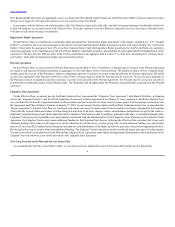FairPoint Communications 2010 Annual Report Download - page 20
Download and view the complete annual report
Please find page 20 of the 2010 FairPoint Communications annual report below. You can navigate through the pages in the report by either clicking on the pages listed below, or by using the keyword search tool below to find specific information within the annual report.
Table of Contents
We believe we own or have the right to use all of the intellectual property that is necessary for the operation of our business as we currently conduct it.
We are subject to extensive federal, state and local regulation. At the federal level, the FCC generally exercises jurisdiction over facilities and services of
common carriers, such as us, to the extent those facilities are used to provide, originate or terminate interstate or international communications. State regulatory
commissions generally exercise jurisdiction over common carriers’ facilities, services and rates to the extent those facilities are used to provide, originate or
terminate intrastate communications. In addition, pursuant to local competition provisions of the Communications Act, as amended by the 1996 Act, state
and federal regulators share responsibility for implementing and enforcing certain pro-competitive policies. In particular, state regulatory agencies exercise
substantial oversight over the offerings of ILECs to competing carriers of interconnection and non-discriminatory access to certain facilities and services
designated as essential for local competition.
Legacy FairPoint and our Northern New England operations operate under different regulatory regimes in certain respects. For example, concerning
interstate access, all of the pre-Merger regulated interstate services of FairPoint were regulated under a rate-of-return model, while all of the rate-regulated
interstate services provided by the Verizon Northern New England business were regulated under a price cap model. On May 10, 2010, we received FCC
approval to convert our Legacy FairPoint operations in Maine and Vermont to the price cap model. Our Legacy FairPoint operations in Maine and Vermont
converted to price cap regulation on July 1, 2010. Under price cap regulation, limits are imposed on a company’s interstate rates without regard to its costs or
revenue requirements. These limits are adjusted annually based on FCC-specified formulae, such as for inflation, as well as through occasional regulatory
proceedings, but will generally give a company flexibility to adjust its rates within these limits. In contrast, rate-of-return regulation permits a company to set
rates based upon its allowed costs and projected revenue requirement, including an authorized rate-of-return determined by the FCC. We have obtained
permission to continue to operate our Legacy FairPoint ILECs outside of Maine and Vermont under the rate-of-return regime until the FCC completes its general
review of whether to modify or eliminate the “all-or-nothing” rule. Without this permission, the all-or-nothing rule would require that all of our regulated
operations be operated under the price cap model for federal regulatory purposes. In addition, while all of our operations generally are subject to obligations that
apply to all LECs, our non-rural operations are subject to additional requirements concerning interconnection, non-discriminatory network access for
competitive communications providers and other matters, subject to substantial oversight by state regulatory commissions. In addition, the FCC has ruled that
our Northern New England operations must comply with the regulations applicable to the Bell Operating Companies. Our rural and non-rural operations are
also subject to different regimes concerning universal service.
We are required to comply with the Communications Act which requires, among other things, that telecommunications carriers offer telecommunications
services at just and reasonable rates and on terms and conditions that are not unreasonably discriminatory. The Communications Act was amended in 1996
by the addition of provisions intended to promote competition in the provision of local services, and to lead to deregulation as markets become more
competitive.
On March 16, 2010, the FCC submitted the National Broadband Plan (the “NBP”) to the United States Congress (“Congress”). The NBP is a plan to
bring high-speed Internet services to the entire country, including remote and high-cost areas. In accordance with the NBP, the FCC has commenced several
rulemakings that concern, among other things, reforming high-cost and low-income programs to promote universal service, to make those funds more efficient
while promoting broadband communications in areas that otherwise would be unserved. We also expect the FCC to undertake new rulemakings addressing
changes to interstate access charges and other forms of intercarrier compensation, classification of broadband providers and other obligations under federal
law. We cannot predict the outcome of these proceedings or the effect that resulting decisions may have on our business.
19
























